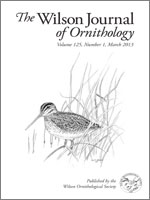We investigated the amount of time Black-tailed Gulls (Larus crassirostris) incubated and its effects on hatching interval within two-egg clutches. Incubation patterns were classified into three categories (rising, steady, or pulsed) related to daily change of incubation rate until clutch completion. Hatching intervals (mean ± SD, 0.95 ± 0.76 days) were significantly shorter than laying intervals (2.56 ± 0.75 days). There was a significant positive relationship between incubation rate on the day when the first egg was laid (day 1) and hatching interval (Spearman's rs = 0.677, P = 0.016). The incubation rate on day 1 also increased (Spearman's rs = 0.521, P = 0.039) as the breeding season progressed, and hatching interval expanded (Kruskal-Wallis test: χ22 = 8.3, P = 0.016, range = 0–2 day). Thus, the amount of time gulls spent incubating on day 1 was important in affecting hatching intervals and suggested that parents partially controlled hatching intervals with seasonal change by timing of the onset of incubation in this species.
How to translate text using browser tools
1 March 2013
Seasonal Changes in Hatching Patterns in Relation to Incubation Behavior of the Black-Tailed Gull (Larus crassirostris)
Naoki Tomita,
Masaoki Takagi
ACCESS THE FULL ARTICLE
amount of incubation
clutch completion
hatching interval
incubation patterns
onset of incubation
seasonal change





